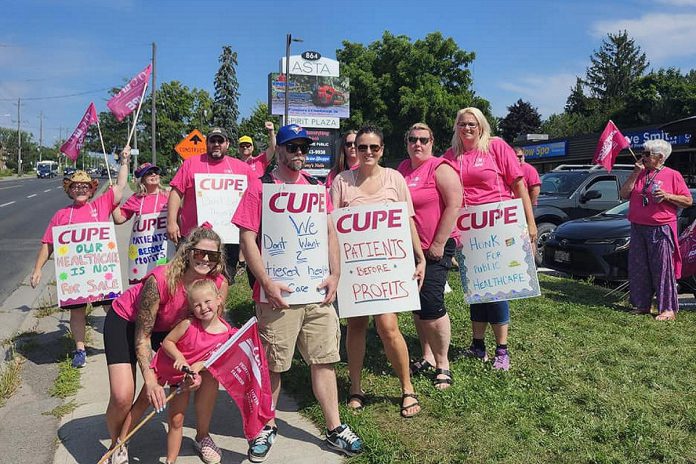
Hospital workers belonging to the Canadian Union of Public Employees (CUPE) gathered outside Peterborough-Kawartha MPP Dave Smith’s constituency office on Chemong Road in Peterborough on Tuesday morning (July 30) to protest the Ontario government’s use of privately owned clinics to deliver publicly funded health care services.
Last January, Premier Doug Ford first announced his government’s plan to move tens of thousands of publicly funded cataract surgeries, hip and knee replacements, MRIs, CT scans, colonoscopies, and endoscopies out of hospitals and into for-profit and not-for-profit community facilities.
“We aren’t accepting a status quo that leaves too many people waiting too long for care,” Ontario health minister Sylvia Jones said at the time, adding that such services would “always be paid for with your OHIP card, never a credit card.”
In June, the Ford government issued a call for applications for new licences for clinics to offer publicly funded MRI and CT scans — a move the government said would allow 100,000 more scans to be provided each year and reduce the existing wait times for scans by around two months.
“Increasing the number of MRI and CT scans being done each year is the next step we’re taking to reduce wait times for more publicly funded surgeries and procedures, ensuring people get the care they need, when they need it,” Jones said in a media release at the time.
Ontario already has more than 900 private clinics, many predating the Ford government, that mainly provide publicly funded X-rays and other diagnostic services. Seven clinics currently provide MRI or CT scans or both. In 2023, four new clinics opened to provide cataract surgeries for around 14,000 patients who have been on waiting lists that grew during the pandemic.

Later this summer or fall, the province plans to launch two more calls for applications for private clinics to offer publicly funded endoscopies and orthopedic surgeries.
Critics have argued that moving publicly funded health care services into for-profit clinics will result in the over-billing of patients as well as the “upselling” of patients to encourage them to pay out-of-pocket for add-on services (such as an upgraded lens in a cataract surgery), and will result in a lower standard of care as clinics process patients as quickly as possible and cut corners to maximize profit.
Some of this is already happening, according to an April 16th report from the Ontario Health Coalition called Illegal, Unlawful and Unethical: Case Studies of Patients Charged for Medical Care in Ontario’s Private Clinics, which claims private clinics are illegally billing patients up to $8,000 for medically necessary services in violation of the Canada Health Act.
“The Ford government says the status quo isn’t working, but it’s a status quo of their own making,” said Michael Hurley, president of CUPE’s Ontario Council of Hospital Unions, in a media release. “They have been underfunding and starving the public system and dangling privatization as a solution. But privatization is twice as expensive and comes with longer waiting lists. We are calling for real solutions to the hospital crisis, like concrete measures to attract and retain new staff and the addition of new beds.”
“Premier Ford famously claimed that Ontarians would never have to pay with their credit card, only their OHIP card,” said Sharon Richer, secretary-treasurer of CUPE’s Ontario Council of Hospital Unions. “People have been told they can either pay for medically needed surgeries or face extreme wait times.”
Pam Parks, president of CUPE 6364 (the union representing workers at Lakeridge Health), said health care workers are concerned the Ontario government is shifting public funding to private health care operators while at the same time not investing sufficiently in the public health care system.
“How is it justifiable that most hospitals in Ontario are facing deficits due to underfunding while public money is being funnelled to private clinics?” she asked. “Staff in public hospitals are overwhelmed, overworked, and under-resourced, but somehow the government has found more money for the much more expensive private clinics — it’s baffling.”
Parks pointed out the existing public hospital system has the capacity to deliver these services, given that many operating rooms across the province remain closed on evenings and weekends.
“You would think that if the main concern was improving surgical wait times, they would make better use of existing capacity in public hospitals,” Parks said. “They are moving in the wrong direction. Health care workers know that the surge of demand for surgeries and diagnostics can best and least expensively be delivered in public hospitals.”
CUPE’s Ontario Council of Hospital Unions represents about 50,000 hospital and long-term care workers in Ontario.



























